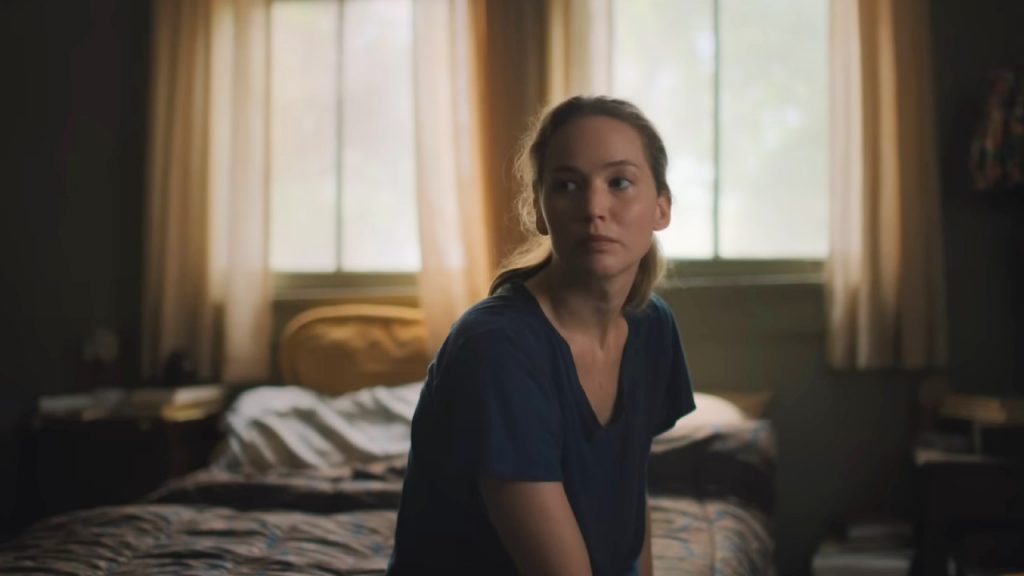The sparse drama “Causeway,” the feature debut of acclaimed theatre director Lila Neugebauer, is immediately apparent in its silent opening moments as a return to the stripped-down indie roots of its Oscar-winning star Jennifer Lawrence. Lawrence’s breakthrough performance in Debra Granik’s harsh and scrappy 2010 film “Winter’s Bone,” which earned the actor her first Academy Award nomination at age 20, was the reason for the actor’s first nomination.
Lawrence looks as young as she did 12 years ago in “Winter’s Bone,” and her performance is a far cry from the steely Katniss Everdeen of “The Hunger Games” trilogy or the operatic goddesses she portrayed in three David O. Russell films (“Silver Linings Playbook,” “American Hustle,” and “Joy”). Lawrence is barefaced, looking wan and thin, and her hair is lank. Although Lawrence’s profile in a blurry close-up allows us to recognise her right away, she is essentially unrecognisable when we first meet her as Lynsey.
Lynsey recently got back from Afghanistan, where an IED blast left her with a catastrophic brain injury. She needs to relearn how to stand, walk, wash, grasp objects, and recall, yet the outside of her body is undamaged, the internal injury is hidden, and she achieves this while receiving patient care from her nurse, Sharon (Jayne Houdyshell). She will soon be well enough to return home, but Lynsey is only able to think of returning and starting work.
Lynsey prefer to flee
Lynsey’s entrance at her mother’s house in New Orleans is hesitant and underwhelming because it is obvious that she prefers to flee rather than go back to her home. She glides cautiously and reluctantly through the world, her face tight from the effort to appear normal and her limbs loose and unreliable. Lawrence frequently adopts a tight, dead-eyed expression (uncomfortably, she hardly ever blinks), but this is on purpose—she is portraying a person suffering from a brain injury and doing everything in her power to appear normal. The actor’s minute, intricate bodily performance is also fascinating to watch.
Lynsey merely goes through the motions, turning up for her pool cleaning job, ignoring her mother (Linda Emond), and hounding her neurologist (Stephen McKinley Henderson) for a work authorization. The secluded “Causeway” comes alive with the arrival of Brian Tyree Henry as James, a mechanic who Lynsey briefly befriends. James lost a limb in a vehicle accident, and the two become friends over burgers and beer as well as their shared traumas.
Henry holds center of gravity
When Henry isn’t on screen, “Causeway” floats aimlessly like Lynsey does. Henry is such an earthy, alluring presence that he holds the centre of gravity throughout the movie. The screenplay, which was co-written by Ottessa Moshfegh and Luke Goebel in addition to Elizabeth Sanders, implies a lot about Lynsey’s background and the spirits who follow her to New Orleans but says very little about them. While Lynsey’s doctor is concerned about the trauma she sustained in Afghanistan, she subtly implies that Lynsey’s traumatising recollections of her birthplace are worse.The camerawork is as impassive and staid as the face of our protagonist in Neugebauer’s aesthetic approach, which adopts the gritty, gloomy, digital style that is currently fashionable in indie film. Lynsey cleans dazzling turquoise pools in the backyards of grand houses while set against the vibrant backdrop of New Orleans. The sheen of dripping sweat reveals the humid atmosphere, while the snippets of jumbled music pulse with the spirit of this location.
It’s a fascinating parallel for this character who holds everything inside, and Lynsey was hurt while working on a dam in Afghanistan with the Army Corps of Engineers. One keeps waiting for “Causeway” to unravel, for the closely guarded secrets to spill out in torrents. The fact that the movie gets its name from the spot where James had his accident—”a elevated road or track across low or damp ground”—indicates that it prefers to stay on the surface, never letting us delve that deeply.
